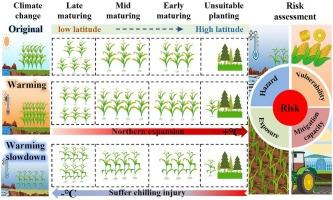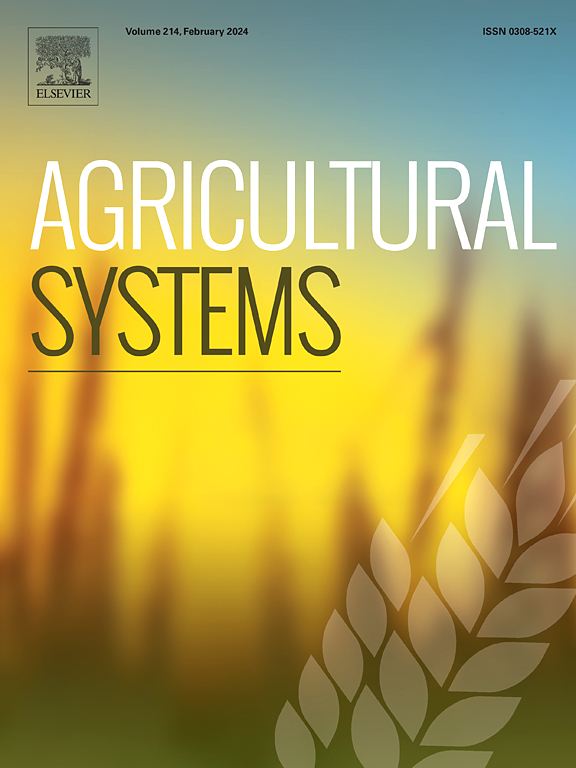The challenge of chilling injury amid shifting maize planting boundaries: A case study of Northeast China
IF 6.1
1区 农林科学
Q1 AGRICULTURE, MULTIDISCIPLINARY
引用次数: 0
Abstract
CONTEXT
With the northward shift of planting belts and increased temperature variability under climate change, chilling injury to crops migrating northward may remain dangerous and worsened by the expansion intensity.
OBJECTIVE
We examined the similarities between adjustments in maize planting and migration systems to identify cold maladaptation using climate and maize planting data from 1981 to 2020.
METHODS
First, the boundaries of maize planting areas were identified based on the critical accumulated temperature thresholds for different varieties, and the range of planting changes was quantified. Next, using the Theil-Sen median and Center of gravity migration model, the trend of maize expansion northward and eastward in Northeast China was revealed. Finally, the chilling injury risk of maize migration in sensitive and non-sensitive growing areas was evaluated for different periods and situations based on the natural disaster formation theory.
RESULTS AND CONCLUSIONS
Maize distribution reacted positively to the Planting system boundary trend with northward movement and eastward expansion. The migration distance and planting rate in sensitive areas were more obvious than in non-sensitive areas, whereas the positive northward adaptation put maize under unfavorable cold conditions, particularly during slowing warming periods. Following the edge of maize migrating to cooler or higher elevation areas, danger of chilling injury has considerably elevated. Overall, compared to non-sensitive areas, newly added maize in sensitive areas exhibited higher vulnerability and hazard levels, alongside lower yields and limited capacity for mitigation. Local farmers have insufficient technical facilities or knowledge of the necessary management after relocation. Using a Multi-Model Ensemble regional climate scenarios, we calculate that High-latitude locations will continue to provide harsh environments for maize, which is susceptible to freezing, even though cropping system boundaries will continue to shift northward, which may present new planting opportunities for maize.
SIGNIFICANCE
Cold adaptation remains crucial when crops move northward to mitigate heat and heat damage caused by global warming.

玉米种植边界变化带来的寒害挑战:中国东北案例研究
背景随着种植带的北移和气候变化下气温变率的增加,北移作物的冷害可能仍然具有危险性,并因扩张强度而加剧。方法首先,根据不同品种的临界积温阈值确定玉米种植区的边界,并量化种植变化的范围。其次,利用 Theil-Sen 中值和重心迁移模型,揭示了中国东北地区玉米向北和向东扩展的趋势。结果与结论玉米分布对种植制度边界趋势呈正向反应,北移东扩。敏感区域的迁移距离和种植率比非敏感区域更明显,而正北向适应则使玉米处于不利的寒冷条件下,尤其是在缓暖期。在玉米向低温或高海拔地区迁移的边缘,冷害的危险大大增加。总体而言,与非敏感地区相比,敏感地区新种植的玉米表现出更高的脆弱性和危害程度,同时产量较低,缓解能力有限。当地农民没有足够的技术设施,也不了解搬迁后的必要管理。利用多模型集合区域气候情景,我们计算出高纬度地区将继续为易受冻的玉米提供恶劣的环境,尽管种植系统边界将继续北移,这可能为玉米提供新的种植机会。
本文章由计算机程序翻译,如有差异,请以英文原文为准。
求助全文
约1分钟内获得全文
求助全文
来源期刊

Agricultural Systems
农林科学-农业综合
CiteScore
13.30
自引率
7.60%
发文量
174
审稿时长
30 days
期刊介绍:
Agricultural Systems is an international journal that deals with interactions - among the components of agricultural systems, among hierarchical levels of agricultural systems, between agricultural and other land use systems, and between agricultural systems and their natural, social and economic environments.
The scope includes the development and application of systems analysis methodologies in the following areas:
Systems approaches in the sustainable intensification of agriculture; pathways for sustainable intensification; crop-livestock integration; farm-level resource allocation; quantification of benefits and trade-offs at farm to landscape levels; integrative, participatory and dynamic modelling approaches for qualitative and quantitative assessments of agricultural systems and decision making;
The interactions between agricultural and non-agricultural landscapes; the multiple services of agricultural systems; food security and the environment;
Global change and adaptation science; transformational adaptations as driven by changes in climate, policy, values and attitudes influencing the design of farming systems;
Development and application of farming systems design tools and methods for impact, scenario and case study analysis; managing the complexities of dynamic agricultural systems; innovation systems and multi stakeholder arrangements that support or promote change and (or) inform policy decisions.
 求助内容:
求助内容: 应助结果提醒方式:
应助结果提醒方式:


